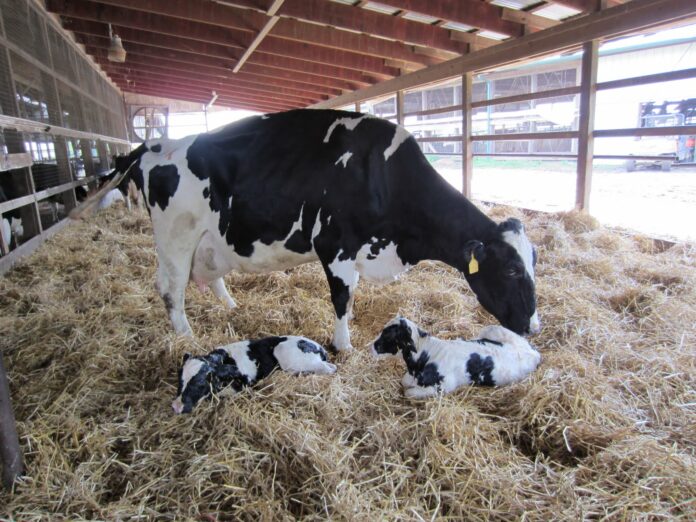Many of the farmers will be encountering calving period soon. That makes this a good time to be preparing your equipment and planning your strategy about the early hours that come with calving season. It is also a good time to reflect on what the calving process entails. Often we take calving for granted and we rely heavily upon the mothering ability of our cows. Still, we need to face the reality that not every cow is a candidate for “Mother of the Year”. Therefore, it is a good exercise for the farmer to reflect on what happens when a new calf arrives and be prepared in case some assistance is needed. Here are the pointers:
Before Birth
Labor has the potential to be a very exhausting and strenuous process for the cow. This can be especially true for first calf heifers. Even when there is not a calving difficulty due to calf presentation or size it is possible that a cow may become too exhausted and give up on the calving process. Additionally, this issue can restrict or even eliminate a cow’s ability to deliver a calf.
A farmer needs to check his/her herd three or four times a day to monitor for such concerns during the calving season. If you feel that a cow is having difficulty you should intervene early. A calf pulled a little early is not a problem, if the cow has fully dilated.
0 to 4 Hours
You expect that calves will be up and will have nursed in the first two hours after birth. Severe weather, injury, illness, or exhaustion can interfere with this. The colostrum milk, which provides the calf with an initial dose of antibodies, is vital in the first four hours after birth. The farmers should check to see if newborn calves have nursed in those first four hours.
It’s often expected that calves that had a difficult birth, were born in bad weather, or are sick will take longer to stand and subsequently are less likely to get maximum antibody exposure. Therefore, you should consider assisting these calves with getting their colostrum. Occasionally, you may have to tube feed a weak calf. In these cases, there are multiple places where you can get colostrum to give to the calf. When deciding where to access colostrum consider that research indicates that there is a selection priority based on quality of the colostrum available.
4 to 12 Hours
It is vital for the calf to get antibodies from the colostrum in the first four hours. These are the ones that will do the most good for the calf. Still, the calf can utilize antibodies consumed within colostrum during the 4 to 12 hour period also. The calf’s digestive tract begins to change as soon as it is born. At birth it has the greatest ability to absorb antibodies and will gradually lose this ability over the first 24 hours of life. By the time the calf is 12 hours old, it has lost 50% of its ability to absorb antibodies from colostrum.
Many dairy farmers will utilize this period to process their calves. It can be easier to handle the new calf than what it may be to run down one that is a couple of weeks old. However, remember that a good mother cow will be very protective of her baby at this time and you need to be wary and alert for your safety.
12 to 24 Hours
If you did not process the calf earlier, this can also be a good time to do so. Evaluate whether or not the calf is nursing and how much fullness does its belly display. This will enable you to know if the calf has a bright and satisfied appearance, act lethargic or if it acts cold .Occasionally, even a healthy newborn calf can suffer from a lack of milk. A few cows, particularly first calf cows may not have strong mothering skills and refuse to allow the calf to suckle.
In some cases the cow’s udder may be plugged or may have a health issue that restricts either milk production. A cow that is demonstrating a mothering problem may need to be penned up in isolation with its calf for the first day or two.
24 to 48 Hours
On the second the calves will be readily capable of following along with the mother cow. However, it is important to remember that the new calf will spend much of its time sleeping for the first week. So don’t expect that it will be following the cow all of the time. Additionally, cows like to hide their calves to protect them from predators for the first couple of days. When you do see the second day calf, it should look perky and well fed. Monitor it for any displays of starvation, hypothermia, or weather stress.
48 to 72 Hours
By the third day you should expect calves to be displaying some “jumpy” behavior. They may be starting to run around, jump, and play. Cows should have fully cleaned by now. If a cow has a retained placenta at this point, you should consider visiting with your veterinarian. The vet may want to prescribe a long acting antibiotic. In some cases they may need to physically remove the placenta.
Pairs that are doing well should be moved out of the calving area onto a large, well-drained area. This should help reduce incidents of scours and other diseases among the young calves. If there are weak calves at this point they and their mother should be paddocked in a well-drained area where extra attention can be provided. The same strategy goes for pairs that suffer from poor mothering abilities. This needs to be a clean and well-drained area. Dirty, wet, and muddy paddocks or stalls can greatly increase the chance of death among weak or sick calves.
Remember, the first 72 hours is critical for your newborn calf.








